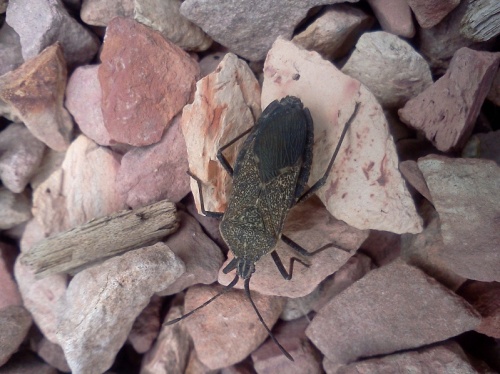Last night on Facebook, a discussion started with a friend who has already found squash bugs on her squash. The discussion continued this morning, with so many participants I felt it was time to talk squash bugs.
Squash bugs are those flat, gray, sideways-crawling, continual egg-laying beasties that can suck a squash plant dry seemingly overnight. The resulting damage is a completely wilted plant that blackens and dies, often with a perfectly healthy plant right next to it. They will attack any plant in the curcubit family (cucumbers, melons, summer squash, winter squash and pumpkins), but seem to prefer squash and pumpkins. They emit a strong odor when crushed, which may have something to do with the lack of natural predators. Without help from birds, lizards and toads, gardeners must take the front line in defending your crops against the invading army of squash bugs. This is a bug I hand-picked (ewwww!) from a squash and threw on the gravel for its photo op. I then stepped on it. This was before I discovered the duct tape solution; I’ll tell you about that later in this post.
Squash bugs can overwinter in the top six inches of soil, under firewood, within garden debris, under stones or dirt clods, or any other protected place near your garden, emerge in the spring and start laying eggs just as you start planting your little squash babies. The first step to controlling squash bugs begins with careful garden clean-up in the fall. Theresa from Tending My Garden suggests the following:
- “Before removing the plants from the garden, I want to kill as many squash bugs as possible. I pull the plants up and leave them — along with any damaged fruits —in a pile on the garden bed. Since squash bugs have a tendency to stay with the vines even after they wilt and reduce in mass, I’m able to check every day for more adults and nymphs – killing all I find.
- I also look for eggs and remove those. (I tear them off, take them with me, and throw them in the trash. They’re next to impossible to crush. So I take no chances of having them hatch anywhere in my yard or garden.)
- Usually it takes about a week before I can’t find anymore bugs. Then I remove the plants and any damaged fruits from the garden.
- By killing as many as you can and removing the food source (the finished plants) from the garden you greatly reduce their chances to make it through the winter. Lowering the numbers that survive is your first step in keeping the prolific squash bug under control.”
The following spring, you should be ahead of the game where squash bugs are concerned, but a few will have escaped your careful cleaning–they are excellent hiders! Your next line of defense will be to sprinkle diatomaceous earth, if you’d like to stay organic, or an insecticide granule with bifenthrin, such as Fertilome’s Vegetable and Ornamental Insect Control, around the base of each squash plant. Diatomaceous earth must be reapplied if it gets wet. Both of these can help control the adult insect. You might also place a board or shingle near the base of the plant. Squash bugs will congregate under them, making it easier to find and squish them.
Companion plantings can also help reduce (but not eliminate!) the numbers of squash bugs. Tammy Biondi writes in Life123 that “catnip, tansy, radishes, nasturtiums, marigolds, bee balm and mint” can be planted near your squash to help repel squash bugs.
A suggestion that came up with last night’s Facebook discussion was using wood ash at the base of the plants. I’ve never tried it and couldn’t find another source to verify it, but the writer says it works. Wood ash is alkaline, so be careful with it if your soil is already alkaline.
Some squash bugs will still escape all of your efforts, so it’s important to be vigilant! Check your plants daily for eggs. Squash bugs lay their tiny, bronze, football-shaped eggs near the intersection of veins on the underside of a leaf.
Removing the eggs and crushing or disposing of them is imperative. My favorite egg removal tool is duct tape. Stick the tape on the section of leaf with eggs and gently pull it away. The eggs will stick to the tape without damaging the leaf! Duct tape is also useful in removing a hatch of squash bug nymphs AND can also be used to capture adults! Duct tape comes in lots of pretty colors and patterns, and you can wear it on your wrist like a bracelet. Fashionable, deadly to squash bugs and satisfying for the gardener. 🙂 Hand picking and squishing the beasties and their eggs is icky, but works. Watering the stems at the base of the plant will send adults scurrying for higher ground, making them easier to catch.
As a word of caution, bees are important pollinators for your squash plants. Insecticides will kill bees, so be careful to not apply them when bees are active. Read labels and follow instructions. If you choose insecticides, be sure to select those that are labelled “safe” for food crops.
Good luck to you, fellow squash bug warriors! The battle will be long, and at times difficult, but you can prevail to have more zucchini than you can possibly use! Be watching the recipe page of this blog for ways to use up your bountiful squash harvest and hopefully prevent you from leaving baseball bat-sized specimens in unlocked cars….. 🙂




thanks for the tips: I’ll try the duct tape for sure.